A Review of the Frequency Estimation and Tracking Problems
P.J. Kootsookos
CRC for Robust and Adaptive Systems
DSTO, Salisbury Site
Frequency Estimation and Tracking Project
February 21, 1999
Abstract
This report presents a concise review of some frequency estimation and frequency
tracking problems. In particular, the report focusses on aspects of these problems
which have been addressed by members of the Frequency Tracking and Estimation
project of the Centre for Robust and Adaptive Systems.
The report is divided into four parts: problem specification and discussion, associ-
ated problems, frequency estimation algorithms and frequency tracking algorithms.
Part I begins with a definition of the various frequency estimation and tracking
problems. Practical examples of where each problem may arise are given. A com-
parison is made between the frequency estimation and tracking problems.
In Part II, block frequency estimation algorithms, fast block frequency estimation
algorithms and notch filtering techniques for frequency estimation are dealt with.
Frequency tracking algorithms are examined in Part III.
Part IV of this report examines various problems associated with frequency esti-
mation. Associated problems include Cram´er-Rao lower bounds, theoretical algo-
rithm performance, frequency resolution, use of the analytic signal and model order
selection.
�
Contents
I Frequency Estimation and Tracking Problems
1 The Frequency Estimation Problem
1.1 Single Tone Frequency Estimation . . . . . . . . . . . . . . . . . . . . . . .
1.2 Multi-harmonic Frequency Estimation . . . . . . . . . . . . . . . . . . . .
1.3 Multi-tone Frequency Estimation . . . . . . . . . . . . . . . . . . . . . . .
1.4 Frequency Estimation . . . . . . . . . . . . . . . . . . . . . . . . . . . . . .
2 The Frequency Tracking Problem
2.1 Demodulation of Digital Signals . . . . . . . . . . . . . . . . . . . . . . . .
2.2 FM Demodulation . . . . . . . . . . . . . . . . . . . . . . . . . . . . . . .
2.3 Tracking in High Noise . . . . . . . . . . . . . . . . . . . . . . . . . . . . .
2.4 Frequency Tracking . . . . . . . . . . . . . . . . . . . . . . . . . . . . . . .
II Frequency Estimation Algorithms
4
4
5
5
6
6
6
7
7
8
8
9
1 Block Frequency Estimators
9
1.1 The Maximum Likelihood Estimator of Frequency . . . . . . . . . . . . . .
9
1.2 Approximate Maximum Likelihood Techniques . . . . . . . . . . . . . . . . 10
1.2.1 The Maximiser of the Periodogram . . . . . . . . . . . . . . . . . . 10
1.3 Fourier Coefficient Techniques . . . . . . . . . . . . . . . . . . . . . . . . . 10
1.3.1 Fourier Coefficient Interpolation Methods . . . . . . . . . . . . . . . 11
. . . . . . . . . . . 11
1.3.2 The Generalised Phase Interpolation Estimator
1.4 Sample Covariance Methods . . . . . . . . . . . . . . . . . . . . . . . . . . 12
Signal Subspace Methods . . . . . . . . . . . . . . . . . . . . . . . . 13
1.4.1
1.4.2 Noise Subspace Methods . . . . . . . . . . . . . . . . . . . . . . . . 13
2 Fast Block Frequency Estimators
14
3 Notch Filtering Techniques
15
3.1 Off-line Filtering Techniques . . . . . . . . . . . . . . . . . . . . . . . . . . 15
3.1.1 The Technique of Fernandes, Goodwin and de Souza . . . . . . . . 15
. . . . . . . . . . . . . . . 16
3.1.2 The Technique of Quinn and Fernandes
3.2 On-line Filtering Techniques . . . . . . . . . . . . . . . . . . . . . . . . . . 17
3.2.1 The Hannan-Huang Estimator . . . . . . . . . . . . . . . . . . . . . 18
. . . . . . . . . . . . . . . . . 18
3.2.2 The Technique of Nehorai and Porat
4 Summary of Frequency Estimation Algorithms
20
4.1 Block Estimators . . . . . . . . . . . . . . . . . . . . . . . . . . . . . . . . 20
�
4.2 Fast Block Estimators
. . . . . . . . . . . . . . . . . . . . . . . . . . . . . 20
4.3 On-Line Estimators . . . . . . . . . . . . . . . . . . . . . . . . . . . . . . . 20
III Frequency Tracking Algorithms
22
1 On-line Frequency Trackers
22
1.1 A Simple Filtering Approach . . . . . . . . . . . . . . . . . . . . . . . . . . 22
1.2 The Extended Kalman Filter . . . . . . . . . . . . . . . . . . . . . . . . . . 23
1.3 The Gaussian ‘Sum’ Approach . . . . . . . . . . . . . . . . . . . . . . . . . 24
2 Hidden Markov Model Approaches
3 Summary of Frequency Tracking Algorithms
IV Associated Problems
1 Cram´er-Rao Lower Bounds
25
25
26
26
2 Performance Indicators
27
2.1 Performance of Frequency Estimation Algorithms . . . . . . . . . . . . . . 27
2.1.1 Approximate Maximum Likelihood Frequency Estimator Performance 28
. . . . . . . . . 31
2.1.2 Weighted-Phase Frequency Estimator Performance
3 The Analytic Signal
4 Frequency Resolution
5 Model Order Selection
6 Summary of the Associated Problems
31
32
33
33
�
Part I
Frequency Estimation and Tracking
Problems
Frequency estimation and tracking problems, algorithms and related topics are discussed
in this report. The aim is to present a concise sketch of these problems, describe current
techniques and indicate loose ends.
In this Part, several estimation and tracking problems are specified and examined.
The two problems to be given most scrutiny in the remainder of the report are single-tone
frequency estimation and single-tone frequency tracking. We discuss the reasons for this
emphasis.
Part II of this report describes several block-processing frequency estimation algo-
rithms, starting with the standard Gaussian, white noise maximum likelihood approach.
Other approaches discussed include the periodogram maximiser, Fourier coefficient in-
terpolation and and sample covariance techniques. Details are then given for some fast
block-processing algorithms which are of interest because of their computational simplic-
ity.
The Part concludes with the examination of several notch filtering techniques for
frequency estimation. The last of these techniques, that of Nehorai and Porat [1986] may
be used as a frequency tracking algorithm, and so this naturally leads on to Part III where
several frequency tracking algorithms are examined.
Further issues such as use of the analytic signal, frequency resolution and model order
reduction are canvassed in Part IV.
Rather than list the possible future directions for research on these topics out of
context, areas where further work is required are indicated throughout the report.
1 The Frequency Estimation Problem
There are three main parameter estimation problems which involve frequency estimation:
• Single tone frequency estimation: where the signal is a single, constant-frequency
sinusoid. This is the simplest frequency estimation problem.
• Multi-harmonic frequency estimation: where the signal is composed of the sum of
harmonically related sinusoids. This case is important because rotational or periodic
phenomena rarely generate sinusoidal waveforms.
• Multi-tone frequency estimation: where there are several tones of unrelated fre-
quency present. This problem occurs in the analysis of signals containing emissions
from more than one target.
Each problem assumes a different signal model is to be fitted to measured data. Due
to the large amount of literature available, this discussion will be confined to the first
problem, that of estimating the parameters of a single tone in noise.
4
�
1.1 Single Tone Frequency Estimation
The single tone in noise parameter estimation problem is defined as follows.
Problem 1: Single Tone in Noise
Let {yt} be generated by the model
yt = µ + ρ cos (ω0(t − ν) + φ) + εt
(1)
where µ is the mean value, ρ is the signal amplitude, ω0 is the frequency of the signal,
ν = T−1
2 , φ is the initial phase and εt is some zero-mean random noise sequence with
variance σ2.
ω0, φ and σ2 given only the measurements {yt : t = 0 . . . T − 1}.
The single tone in noise problem is then to estimate the real-valued parameters µ, ρ,
2
A related problem is estimation of the parameters in the following signal model:
t
zt = µ + ρ exp i (ω0(t − ν) + φ) + ε
where the parameters are as before, except that both µ and ε
t are complex-valued. Rife
and Boorstyn [1974] examined this case. For the majority of this report, however, we
shall confine our discussion to the real signal model yt of (1).
Remark 1: The signal model (2) is sometimes referred to as the analytic signal (Ville
[1948]) model.
2
In all of these problems, algorithm selection depends on whether the sample size T
is fixed or increasing. If T is fixed, block-processing algorithms are considered. For T
increasing, on-line algorithms are of interest.
(2)
1.2 Multi-harmonic Frequency Estimation
Where frequency information is to be gleaned from acoustic sources such as rotating
machinery, non-linear effects within the generating system often give rise to harmonics
and sub-harmonics of the fundamental mode of interest.
In these situations, (1) does
not model the physical situation well, so a signal model which accounts for the added
harmonics should be used.
Such a signal model is given below.
Problem 2: Harmonically-related Tones in Noise
Let {yt} be a multi-harmonic signal modelled by
p
yt = µ +
ρj cos (jω0(t − ν) + φj) + εt
(3)
j=1
where µ, ν, εt and σ2 are defined as in Problem 1 and ω0 is now the fundamental frequency
of the signal, ρj is the amplitude of the jth harmonic and φj is the initial phase of the jth
harmonic.
µ, ρj, ω0, φj, σ2 and p given only the measurements {yt : t = 0 . . . T − 1}.
The multiharmonic-related tones in noise problem is then to estimate the parameters
2
The papers by Barrett and McMahon [1987], James, Anderson and Williamson [1991a]
and James, Anderson and Williamson [1991b] examine the multiharmonic frequency es-
timation problem.
5
�
1.3 Multi-tone Frequency Estimation
In certain environments, several tonal sources of differing frequencies may be present in
the one signal. While, in some cases, it may be possible to apply single-tone techniques in
this situation, it is more desirable to account for the extra problem complexity by altering
the signal model.
The multiple tones in noise problem is defined as follows.
Problem 3: Multiple Tones in Noise
Let {yt} be a multi-tonal signal modelled by
p
yt = µ +
ρj cos (ωj(t − ν) + φj) + εt
(4)
j=1
where µ, ν, εt and σ2 are defined as in Problem 1 and ωj is now the frequency of the jth
signal component, ρj is the amplitude of the jth tone and φj is the initial phase of the jth
tone.
σ2 and p given only the measurements {yt : t = 0 . . . T − 1}.
The multiple tones in noise problem is then to estimate the parameters µ, ρj, ωj, φj,
2
Hannan [1973] has examined this case and Rife and Boorstyn [1976] have examined
the equivalent complex signal model problem.
1.4 Frequency Estimation
In this report, we shall only examine in detail algorithms for the frequency estimation
problem. The main reason for this is that the added complexity introduced by signal
models (3) and (4) obfuscates some of the key issues by either introducing new problems
or by increasing the dimensionality of the problem.
For instance, use of model (4) instead of (1) means that model order selection now
becomes an issue. We shall discuss this and other issues further in Part IV.
2 The Frequency Tracking Problem
The frequency tracking problem is somewhat more complicated than the estimation prob-
lem. Three physical situations where frequency tracking is of interest are
1. decoding digital information from a frequency-shift keyed bit stream,
2. in demodulation of an FM radio signal and
3. tracking the revolutions per minute of the engine of a manœuvring vessel via acoustic
data.
Each of these three problems may be described by the following general problem state-
ment.
6
�
Problem 4: Frequency Tracking
Let {yt} be modelled by
yt = µ + ρ cos
t
k=0
ωk + φ
+ εt
(5)
where ωk is called the instantaneous frequency of the signal and µ, ρ, ν, φ, εt and σ2 are
as defined in Problem 1.
σ2 and the sequence {ωk} given only the measurements {yt : t = 0 . . . T − 1}.
The frequency tracking problem is then to estimate the signal parameters µ, ρ, φ and
2
Boashash [1992a] gives a general discussion of the problem of instantaneous frequency
estimation.
Remark 2: The most notable difference between this problem and Problems 1 to 3 is that
the estimation of µ, ρ, φ and σ2 is a parameter estimation problem, whereas estimation
of the sequence {ωk : k = 0 . . . T − 1} is a state estimation problem.
2
Remark 3: The definition of this tracking problem does not immediately suggest an ap-
propriate error measure. In parameter estimation problems it is common to use the least
square error criterion. However, in tracking problems, concepts such as ‘loss of track’ or
‘escape time’ may be of more importance.
2
The escape time for the phase locked loop frequency tracker has been examined by
Dupuis and Kushner [1987].
The three physical situations above may be examined by suitable selection of various
parameters in Problem 4. Because of this different parameter selection, some algorithms
may be more appropriate to apply to certain problems than others.
2.1 Demodulation of Digital Signals
For example, when a frequency-shift keyed bit stream is to be decoded, ωk will be at known
constant values for some duration, which is also perhaps known. While the constant
frequencies are known, the change from frequency to frequency is generally stochastic.
Remark 4: In this situation, hidden Markov models are probably the most appropriate
approach to take due to the discrete nature of process of interest.
2
2.2 FM Demodulation
For the FM demodulation problem, set
ωk = ωc + λk with ωc λk
where ωc is the carrier frequency and λk is the speech signal to be demodulated. The fre-
quency variation λk may possibly be modelled as an auto-regressive (or linear predictive)
process.
In these cases, the noise is generally fairly small. For instance, because of the effect
of threshold which is characterised by a severe degradation in reception below some noise
level, the signal (or carrier) to noise ratio (SNR) for a commercial (stereo) FM station is
usually required to be
10 log10
ρ
2σ2 > 20dB.
7
�
Remark 5: A major difference between this problem and that of digital signal demodulation
is that here the frequency variation itself is modelled as being stochastic.
2
2.3 Tracking in High Noise
For the manœuvring vessel problem, ωk will be slowly time-varying while, in general, the
noise is large. For the underwater case, the operating signal to noise ratio is generally
10 log10
ρ
2σ2 < −20dB.
Fortunately, because of a priori knowledge of the working environment, only a small band
of known frequencies is generally of interest.
Remark 6: The frequency tracking problem in this situation is thus further constrained to
take place within a known ‘gate’ of possible frequencies.
2
Remark 7: A problem that also needs attention is that of deciding whether or not an
interesting signal is present given knowledge of the background noise. The issues are
called track initiation or detection and track termination and they are of major concern.
2
2.4 Frequency Tracking
Part III of this report examines some particular frequency tracking algorithms, and some
other aspects of the problem are examined in Part IV.
Further Work 1: Methods for allowing a priori information about
the instantaneous frequency law ωk to be used should be examined.
Further Work 2: Block estimators of frequency may be used as
frequency trackers, provided the frequency variation is slow enough
over the length of the data. Bounds on the performance of block
and on-line techniques, for a given amount of frequency variation
(specified either stochastically or deterministically), would allow
direct comparisons between such techniques to be made.
Multi-harmonic and multi-tone extensions of Problem 4 may also be defined, however
they are not discussed here as this will overly complicate the problem.
8
�
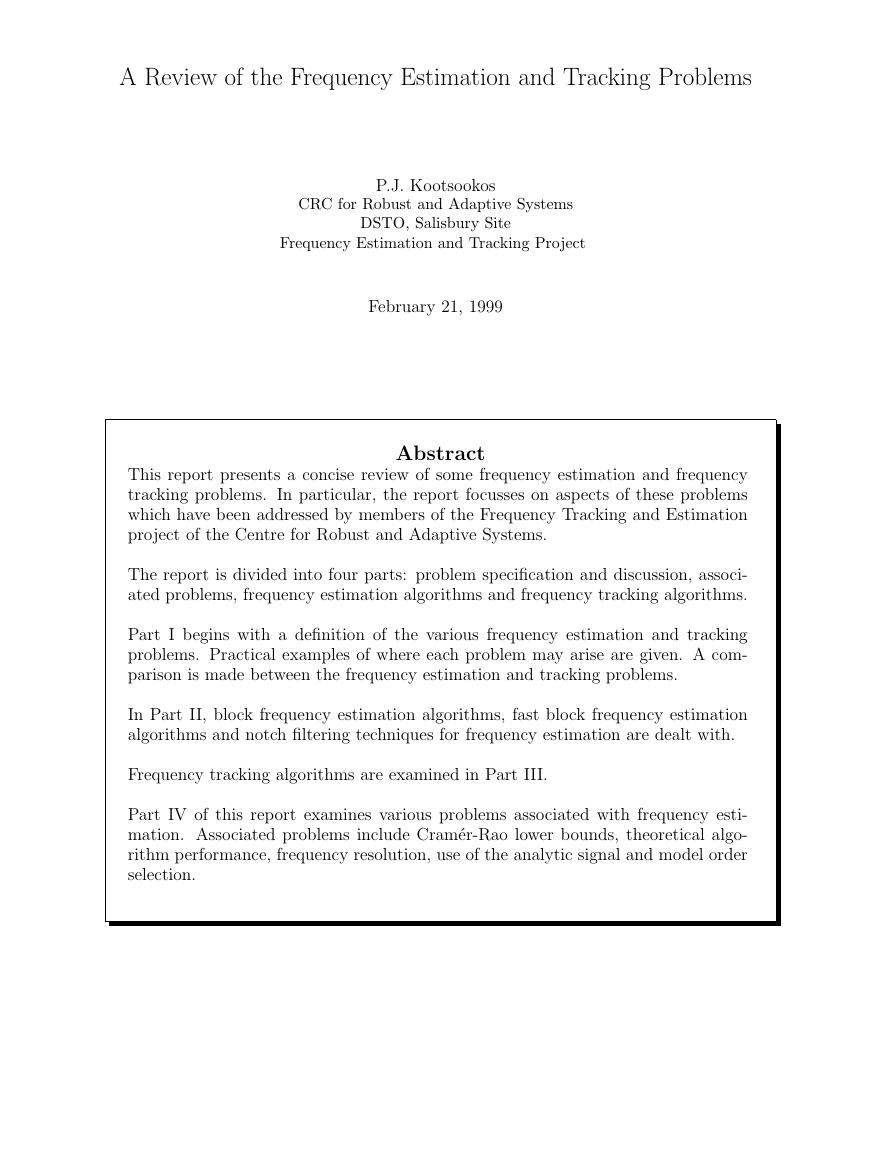

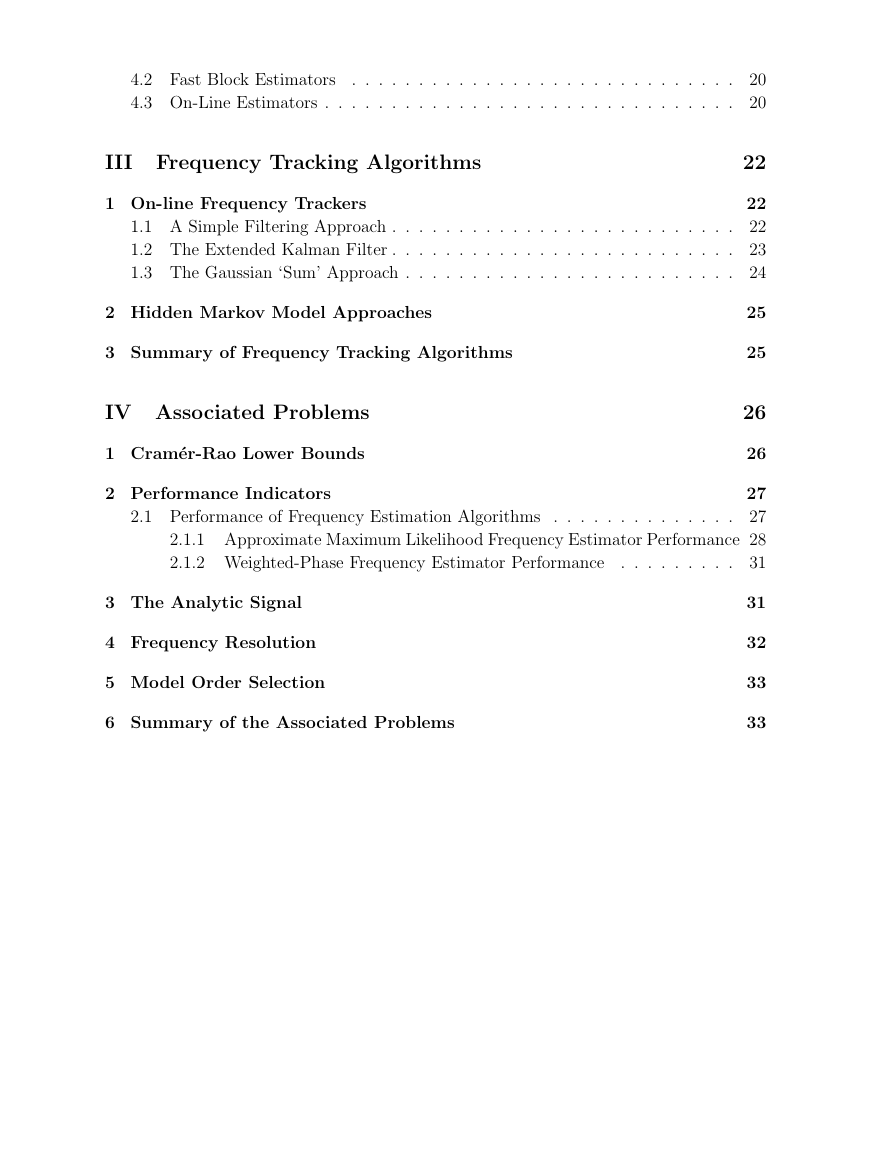

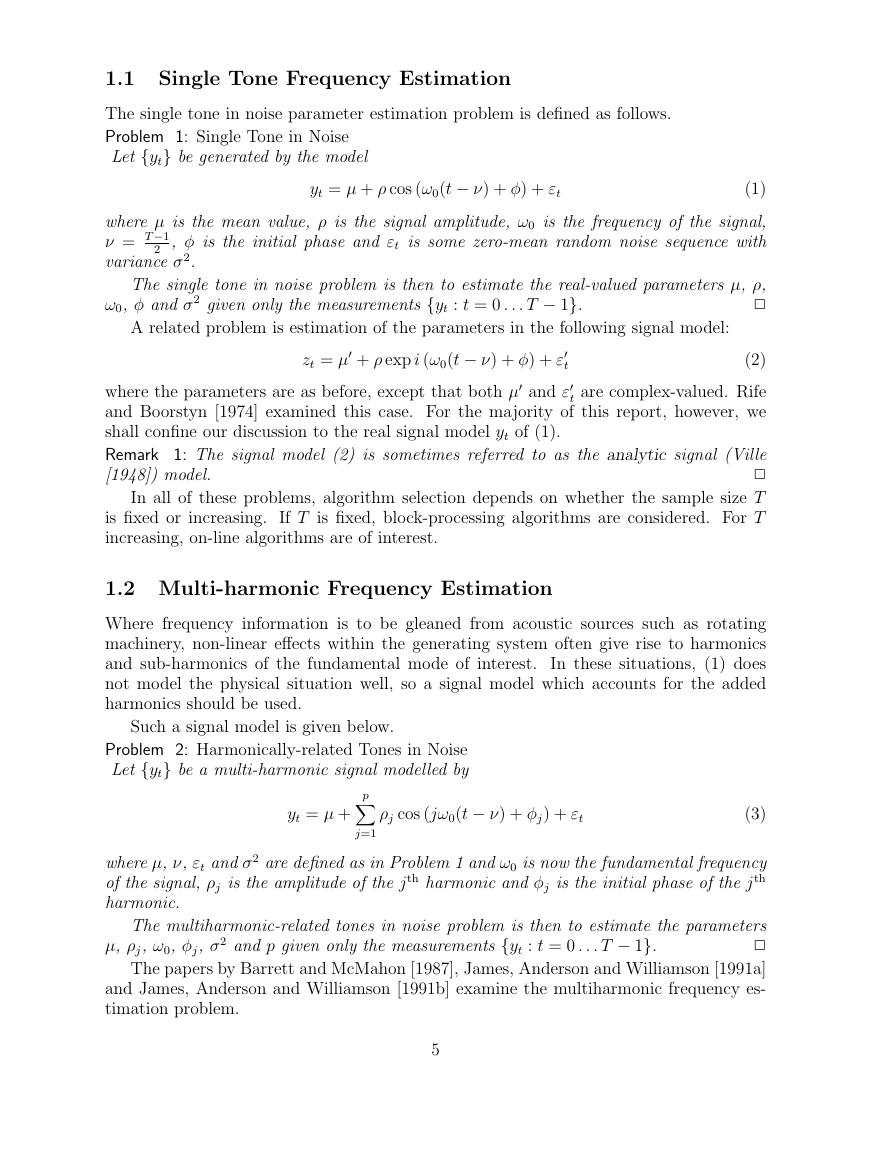
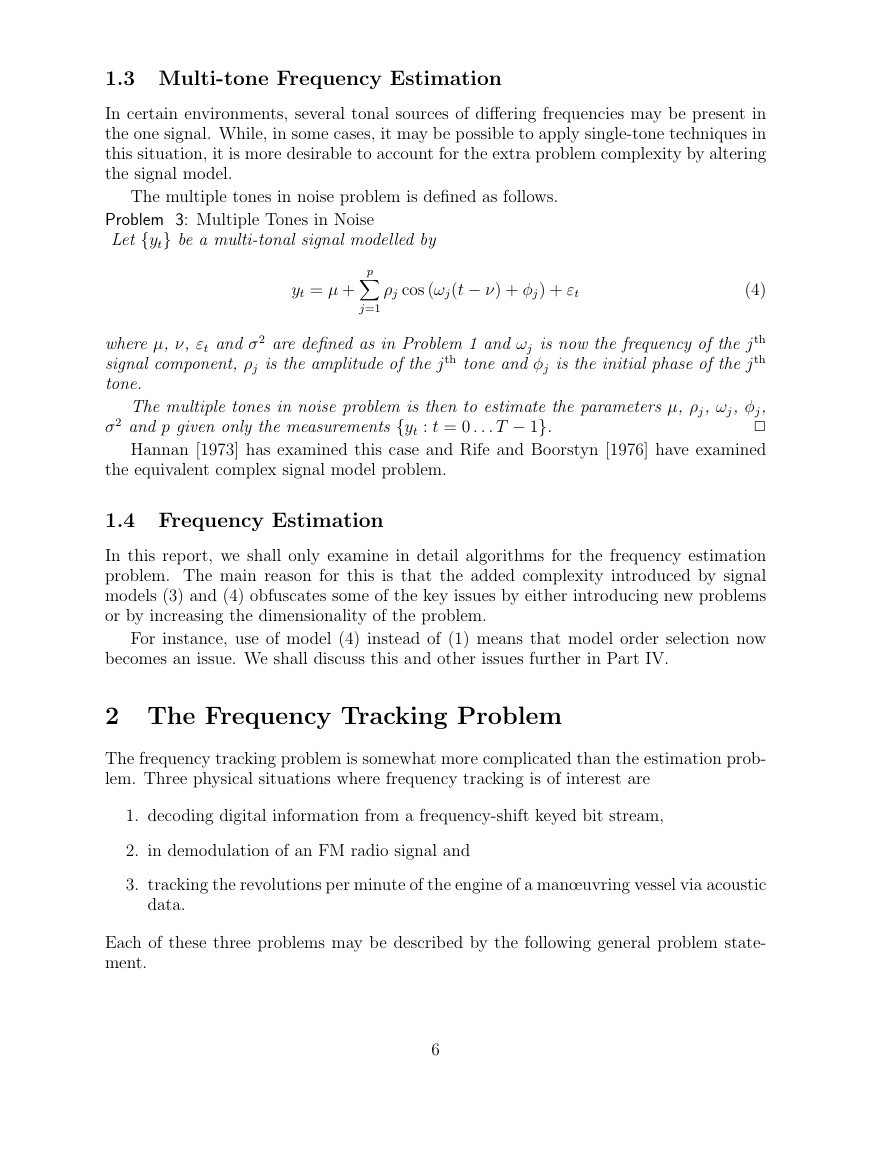
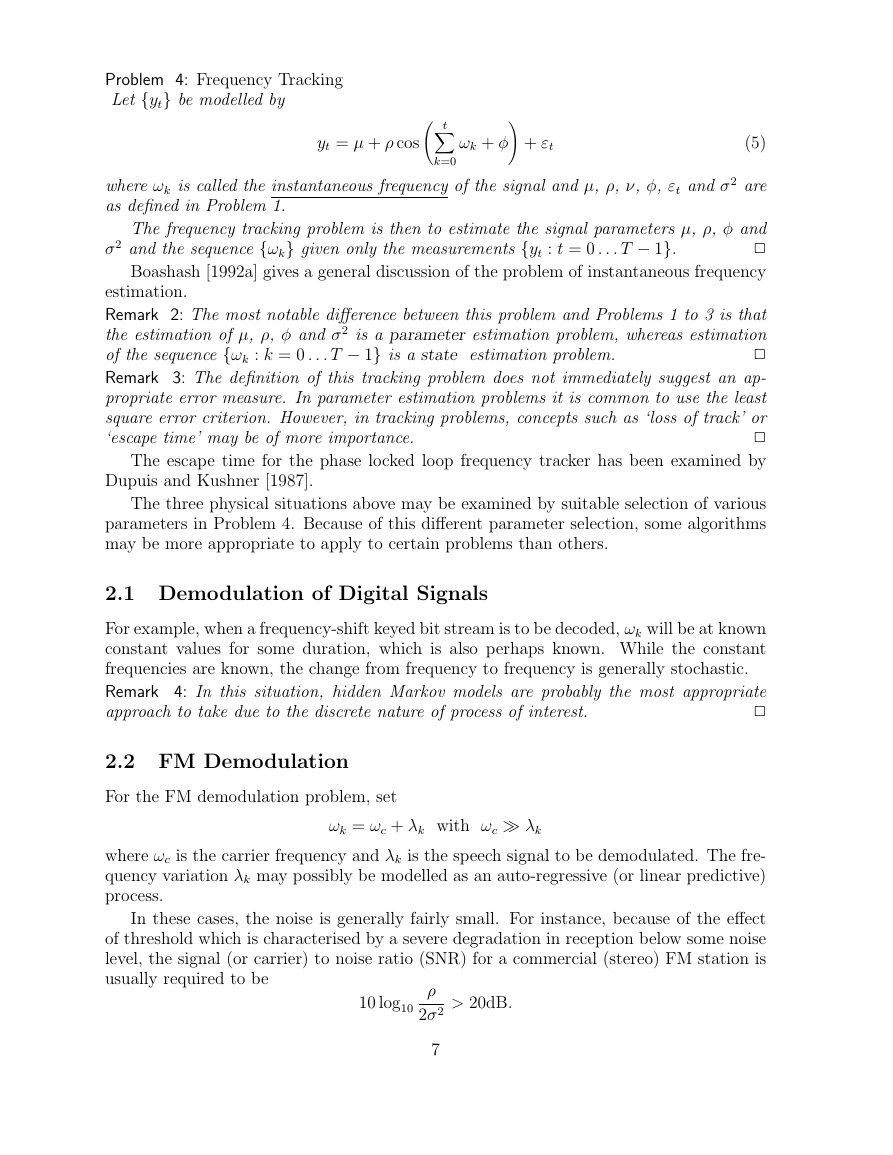









 2023年江西萍乡中考道德与法治真题及答案.doc
2023年江西萍乡中考道德与法治真题及答案.doc 2012年重庆南川中考生物真题及答案.doc
2012年重庆南川中考生物真题及答案.doc 2013年江西师范大学地理学综合及文艺理论基础考研真题.doc
2013年江西师范大学地理学综合及文艺理论基础考研真题.doc 2020年四川甘孜小升初语文真题及答案I卷.doc
2020年四川甘孜小升初语文真题及答案I卷.doc 2020年注册岩土工程师专业基础考试真题及答案.doc
2020年注册岩土工程师专业基础考试真题及答案.doc 2023-2024学年福建省厦门市九年级上学期数学月考试题及答案.doc
2023-2024学年福建省厦门市九年级上学期数学月考试题及答案.doc 2021-2022学年辽宁省沈阳市大东区九年级上学期语文期末试题及答案.doc
2021-2022学年辽宁省沈阳市大东区九年级上学期语文期末试题及答案.doc 2022-2023学年北京东城区初三第一学期物理期末试卷及答案.doc
2022-2023学年北京东城区初三第一学期物理期末试卷及答案.doc 2018上半年江西教师资格初中地理学科知识与教学能力真题及答案.doc
2018上半年江西教师资格初中地理学科知识与教学能力真题及答案.doc 2012年河北国家公务员申论考试真题及答案-省级.doc
2012年河北国家公务员申论考试真题及答案-省级.doc 2020-2021学年江苏省扬州市江都区邵樊片九年级上学期数学第一次质量检测试题及答案.doc
2020-2021学年江苏省扬州市江都区邵樊片九年级上学期数学第一次质量检测试题及答案.doc 2022下半年黑龙江教师资格证中学综合素质真题及答案.doc
2022下半年黑龙江教师资格证中学综合素质真题及答案.doc